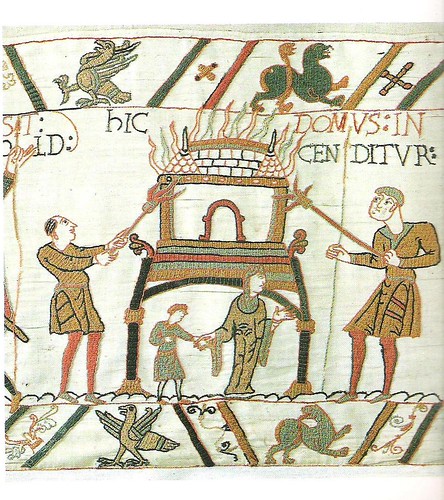How Needlework Was Used to Re-Write History – the Secret of the Bayeux Tapestry
 You do not have to be a needlepoint enthusiast like me to appreciate the magnificent Bayeux Tapestry, which chronicles the events leading up to the conquest of England by Duke William of Normandy in the year 1066.
You do not have to be a needlepoint enthusiast like me to appreciate the magnificent Bayeux Tapestry, which chronicles the events leading up to the conquest of England by Duke William of Normandy in the year 1066.
Technically speaking it is not a tapestry at all – but an embroidery, stitched with wool on a linen background by a team of needle workers. But the interesting question is: was it made just to celebrate a great victory?
To answer this question you have to consider the political situation at the time. Duke William claimed that the King, Edward the Confessor, had promised him the throne of England. However this event had not been properly witnessed or recorded. He also claimed that Harold, the future King of England, had previously sworn allegiance to him. But Harold had been imprisoned in France at that time, and his actions could have been misunderstood.
On Edward’s death, William of Normandy had expected to ascend the English throne. But instead Harold disputed his claims, insisting that the Kingdom had been bequeathed to him by the dying monarch, and was duly crowned King. William replied to this by invading England, defeating the English army and killing King Harold at the Battle of Hastings.
Now the new King William had to ensure that history told the story his way. What better way to achieve this than with a huge 230 feet long tapestry – a priceless work of art, which would be preserved for centuries, and confirm his right, and that of his successors, to the throne of England.
Thus the whole scene of Edward promising his crown to William, and Harold swearing allegiance, was stitched into the tapestry, and recorded for all time. Picture an era when very few people could read, and imagine the visual impact of this story told in vivid images, complete with the mangled bodies of the dead in battle. Even today you can walk along beside the Tapestry, and the whole epic story unfolds before your eyes, just as William the Conqueror intended, a thousand years ago.
The Da Vinci Code was an example of a good, but unconvincing attempt to re-write history. But the Bayeaux Tapestry succeeded!
Tom McMorrow is a partner at Cross Stitch Centre, the specialist needlecraft retailer - visit their website http://www.cross-stitch-centre.co.uk and learn more about tapestry needlepoint, cross stitch and embroidery.
by Tom McMorrow

